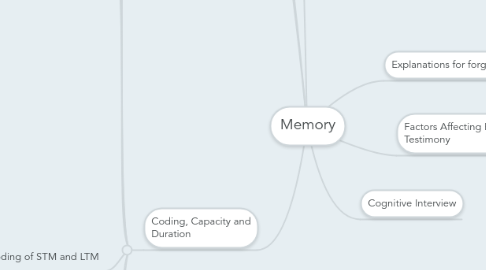
1. Coding, Capacity and Duration
1.1. LTM: A potentially permanent store, with unlimited capacity and duration, coded semanitically.
1.2. STM: Memory for immediate events and tasks, coded acoustically, duration of 18-30 seconds and a capacity of 5-9 items.
1.3. Jacobs and Miller: Capacity of STM
1.3.1. Developed a digit span technique
1.3.2. Asked for immediate recall when they asked participants to recall numbers and letters
1.3.3. Found average recall for digits was 9.3 and letters was 7.3
1.3.4. Miller noticed that things in everyday life tend to come in 7's, such as days of the week
1.3.5. Developed the idea of chunking, BBC is one chunk but 3 individual letters
1.3.6. Concluded that we can recall 5-9 chunks of information not just individual numbers or letters
1.3.6.1. Cowan suggested that our STM is limited to 4 chunks
1.3.6.2. Simon suggested that it is the size of the chunk that matters, larger the chunk, the fewer you can remember
1.3.6.3. Jacobs found that memory improved with age, and found that 8 year olds could recall 6.6 digits but 18 year olds 8.6 digits
1.4. Baddeley: Coding of STM and LTM
1.4.1. Had 4 different groups and asked them to learn a list of words
1.4.2. List were either semantically similar or dissimilar, acoustically similar or dissimilar
1.4.3. Asked for immediate recall or waited 20 minutes to test LTM
1.4.3.1. Questioned as to whether 20 minutes is long enough to test LTM
1.4.4. Found that when asked for immediate recall participants did worse with acoustically similar words and after 20 minutes they did worse with semantically similar
1.4.5. Overall, concluding that STM is coded acoustically and LTM is coded semantically
1.4.5.1. Brandimote gave participants a visual task and prevented verbal rehearsal and found they used visual coding
1.4.5.2. Wickens suggested that semantics may be involved in STM
1.5. Peterson & Peterson: Duration of STM
1.5.1. Had 24 participants who were tested over 8 trials
1.5.2. Asked to learn a consonant syllable and a 3 digit number, such as THX 876
1.5.2.1. Criticises for lacking ecological valdity
1.5.3. They were asked to recall after a retention time of 3, 6, 9, 12, 18 seconds
1.5.4. They were prevented from verbal rehearsal by counting backwards
1.5.4.1. Reitman used auditory tones in order to see if the results were due to displacement not decay and found the duration to be longer, suggesting results don't show decay
1.5.5. Found that recall was 90% accurate after 3 seconds, 20% accurate after 9 seconds and 2% accurate after 18 seconds
1.5.5.1. Nairne suggests duration is up to 96 seconds
1.6. Baharick et al: Duration of LTM
1.6.1. 400 participants aged between 17-74
1.6.2. Asked for free recall and photo recognition of their old classmates
1.6.3. Free recall saw 60% accuracy after 15 years and 30% accuracy after 48 years
1.6.4. Photo recognition saw 90% accuracy after 15 years and 70% accuracy after 48 years
